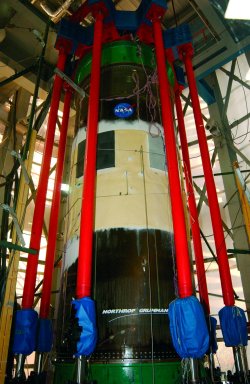Northrop Grumman technology poised for role in future space exploration programmes
Leak-proof composite cryogenic fuel-tank technology developed by Northrop Grumman for NASA's now-defunct programme to develop a second-generation reusable launch vehicle (RLV) could find application under the US space exploration initiative.
Efforts to develop a lightweight composite tank that does not permit liquid hydrogen to leak could lead to its use for storing fuels in space while the elements of a manned mission to the Moon or Mars are assembled in orbit. Alternatively, the insulated and leak-proof tanks could be converted into habitats in orbit, says project leader Tod Palm.
A prototype tank developed over three years under NASA contracts totalling $30 million last month completed a 40-cycle series of tests leak-free, says Palm, withstanding mechanical and thermal stresses associated with repeated fuelling and simulated launches. The test article, a quarter-scale model of a fly-back booster tank, is both pressure vessel and primary load-bearing structure, he says.
Work began in 2001 after NASA experienced hydrogen leaks with the composite cryogenic fuel tank for the ill-fated Lockheed Martin X-33 RLV technology-demonstrator. The leaks were caused by microcracking of the carbonfibre tank wall.
Northrop Grumman's cryotank has a sandwich wall construction, with inner and outer carbonfibre-laminate skins and non-metallic honeycomb core. To prevent microcracks, the thickness of carbonfibre layers was halved to double the number of cross-laminates. This suppressed microcracking by a factor of 16, says Palm.
A layer of aluminium foil was added between the inner skin and the honeycomb core to act as a permeation barrier and second layer of leak prevention. Finally, the perforated core is placed under a vacuum to vent any hydrogen that does escape. The vacuum also allows the honeycomb to act as an insulator, says Palm.
Northrop Grumman also developed a method of producing the large tank without expensive autoclave processing. This involved ultrasonic tape lamination, which uses ultrasonic energy to compact the resin-impregnated fibre into its final shape, after which the completed structure was cured in an oven at ambient pressure.
Palm says Northrop Grumman plans to submit two proposals under NASA's Project Constellation exploration programme: one to use the tanks to store cryogenic fuels on orbit for several months as the elements of a Moon or Mars mission are launched and assembled in orbit; and one to convert empty tanks into pressurised, insulated habitation modules.
GRAHAM WARWICK / WASHINGTON DC

Source: Flight International
















